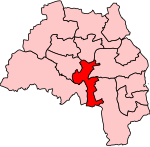Felling is an eastern suburb of Gateshead, Tyne and Wear, England. The town was formed when three villages coalesced in the 19th century. Historically part of County Durham, the town was subsumed into the metropolitan borough of Gateshead in 1974. It lies on the B1426 Sunderland Road and the A184 Felling bypass, less than 1 mile (1.6 km) east of Gateshead town centre, 1 mile (1.6 km) south east of Newcastle-upon-Tyne and 10 miles north west of the City of Sunderland. In 2011, Felling had a population of 8,908.
The history of Felling stretches almost eight hundred years. The original manor at Felling was granted in the 13th century and passed through several families until it was passed to the Brandling family in 1509. While Lords of the Manor, several members of this family served as Members of Parliament among other civic duties. They were also instrumental in bringing heavy industry to the area, and Felling Colliery (John Pit), one of the oldest and largest collieries in the region, was developed on their estate. The colliery was the site of two mining disasters which cost over one hundred lives, helping prompt Sir Humphry Davy and George Stephenson to develop their safety lamps (there is a monument to the workers lost in St Mary's churchyard, Heworth). Other heavy industry took root in the 18th and 19th centuries so that Felling developed from a rural scattering of villages into firstly three distinct settlements at Low and High Felling and Felling Shore, then in 1894 these amalgamated with other local villages into the town of Felling, administered by the Felling Urban District Council at Sunderland Road. The areas that Felling council were responsible for were Felling, High Felling, Windy Nook, Whitehills Estate, Leam-Lane Estate, Pelaw, Wardley, Heworth, Bill Quay and Follingsby. The council was disbanded in 1974 when Felling was wholly incorporated into the new Metropolitan Borough of Gateshead.
Felling today is broadly residential save some light industry located at the bank of the River Tyne in north Felling. It is governed locally and nationally by the Labour Party. The vast majority of residents identify as white British and, in the north areas particularly, there are high levels of unemployment and deprivation. It is well served by public transport; there are several bus services through the area and Felling lies on the Tyne and Wear Metro line and there are stations at Gateshead Stadium and Felling. Felling town centre remains the principal economic area and has recently benefitted from a £13.5 million regeneration project, with the demolition of the old Co-op supermarket and council building and rebuilding of the town shopping centre shopping units, which now run parallel to a new Asda superstore. The long and rich history of the area is reflected by over a dozen listed buildings, several churches and numerous public houses which are locally listed. It is served by several schools, though levels of educational qualification among residents are comparably low. Leisure provision is good, with four distinctive parks and various riverside facilities. Gateshead International Stadium lies in the area and several professional footballers hail from Felling, including former England international Chris Waddle, as does award-winning author David Almond.






